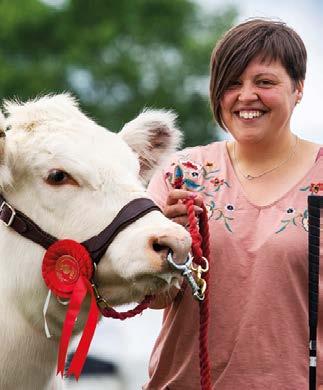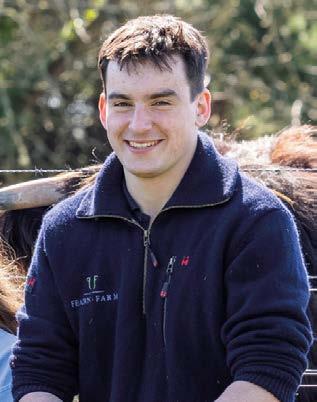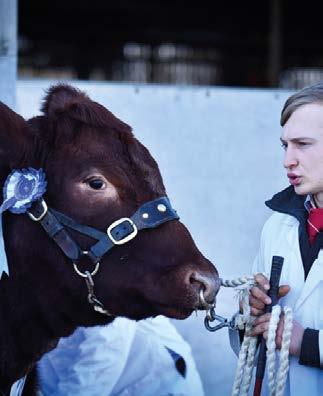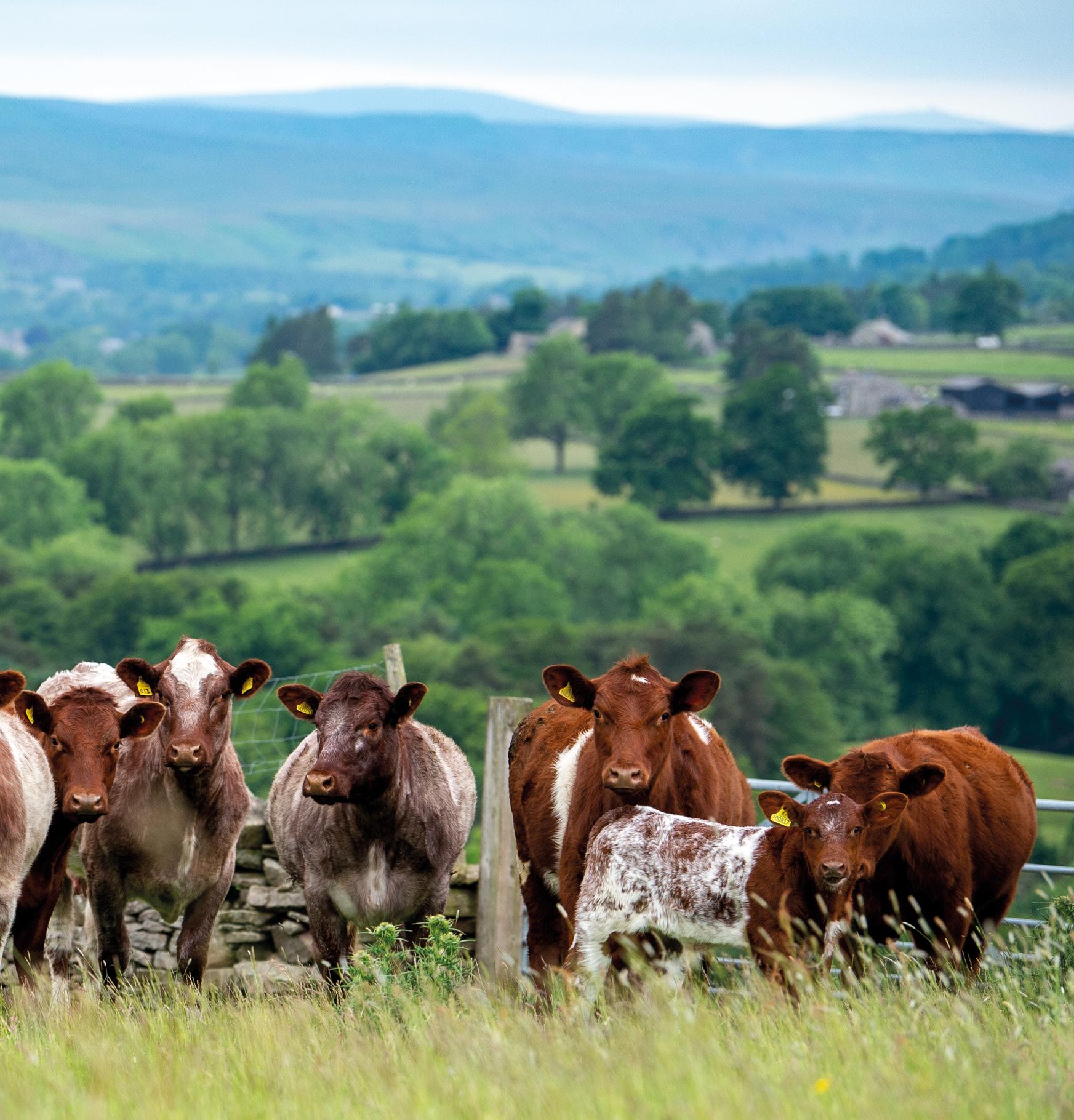
8 minute read
NextGen; Our future
UK agriculture is embracing some significant transitions as the Basic Payment Scheme (BPS) is phased out, and more focus is placed on the environment. Sarah Alderton speaks to five next-generation beef producers at the start of their farming journey to find out how they feel about the future, what got them into farming and their love of the Beef Shorthorn.
#NEXTGEN
Advertisement

Emma Trueman Roundhill herd, Staffs/Derbys border
• 30 pedigree females and 50 head run across approximately 40ha
• Works full time as veterinary practice manager at Moorland
Veterinary Centre,
Staffs
• Increased the herd through embryo transfer, flushing and AI
How did you get into farming?
Farming is in my blood. My grandparent’s farmed dairy, beef and sheep in Staffordshire and delivered animal feed. I was also a member of Young Farmers.
Twelve years ago, when I was 21/22, I decided to set up my herd. A great opportunity arose when 18ha and a shed came up for sale, so I bought it. I started with two foundation females; one was from Mark Holmes of the Holmeere herd and the other female was from Chelford Market from Mrs Robson of the Lynthorpe herd. I also purchased some commercial cattle.
Why Beef Shorthorn?
I wanted a docile breed since I would be working with the stock on my own and since joined by my partner, Dave and brother Andrew; they are always on hand to help out. The breed can also thrive on low inputs, and they are hardy, which was needed since the ground I own near Flash on the Staffordshire/ Derbyshire border is 1,500ft above sea level. It’s like winter in the summer.
How many cattle do you have?
My entire herd is now Beef Shorthorn and I have about 50 head, with 30 breeding females. I also rent another 20ha. One of my foundation cows, the Lynthorpe cow, has been flushed and I have done a lot of embryo work and AI. She had excellent maternal traits and everything she has produced I liked. I have retained a lot of females, which has allowed me to build up the herd.
What do you enjoy most about having cows?
It’s like having a second family. I get a lot of enjoyment seeing something go on and do well. I do a bit of showing and have been to the UK Championships at the Great Yorkshire Show a few times. This year I took a first with a yearling heifer. Locally, I have won a few interbreeds.
#NEXTGEN

James Scott Fearn herd, Inverness
• Second-year student studying HND
Agriculture at SRUC,
Edinburgh I grew up on Fearn Farm, the family unit which today consists of 4,000 breeding ewes - mainly Aberfield cross, 100 purebred Beef Shorthorn cows, 60 Luing, and some arable. We also contract farm 50 Luing and buy-in steers to finish for a beef box scheme.
Farming has always been in my blood and I plan to come home to the family farm when I finish studying at SRUC, Edinburgh. However, in the next 10 years, I would also like to go travelling to Australia and New Zealand. I would like to see the different farming techniques they use and look for new ideas to bring back to Fearn Farm.
How do you feel about the future of UK agriculture?
There’s a massive opportunity for young people in the industry to do their own thing. At Fearn Farm, I think we are in a good position to ride the ups and downs due to the diversity of stock we have, the type of stock and our holiday let diversification.
Eating quality is also important and is something we are aware of. I think this will only become more important in the future.
What do you enjoy most about farming?
I get great satisfaction from seeing quality stock on the farm. We have worked hard over the years to build up a good herd. We are now selling pedigree stock through an online platform called Your Bid. We used it for the first time in Covid; it was developed by the Giddings farming family in New Zealand. It opens up your herd to a wider audience.

#NEXTGEN

Tori Henderson Sharpsbridge herd, East Sussex
• 12 breeding females, four in-calf heifers and followers
• Established herd in 2019, with partner
Andrew Pagett
• Renting 20ha from the Sutton Hall
Estate, Lewes
How did you get into farming?
My route came when I got a job at a hunt kennel where I did various jobs, such as running the fallen stock scheme. I then got a job in 2916 with Sarah Wilkins of the Rumsden herd, which was where I was first introduced to Beef Shorthorns and instantly fell in love with them. Sarah ended up dispersing her herd, and that’s when we decided to establish our own herd. We ended up with a lot of her cattle.
What is your aim for the herd?
We are currently tightening the calving patterns and injecting some different genetics into the herd. We have received some help from Charles and Sally Horrell, who have lent us a couple of bulls to use on our cows as we don’t own a bull.
We aim to continue improving the herd by injecting new genetics. The cows have got to make us money for us to spend money. We have recently sold a couple of bulls locally and finished a few through the market. There is a strong market for Beef Shorthorn bulls from local dairy farmers.
Our aim long term is to focus on selling females through Society sales. I would also like to get back into showing as I did a lot with Sarah, but then Covid shut that down. In the future, I hope to promote the breed and our herd through local shows and the UK Championships at the Great Yorkshire Show. I would also like to increase the herd to 20 breeding females.
How do you feel about the future in farming?
It’s quite a worrying time for farmers. However, people need to eat, and I think we are breeding a cow that is fit for the future due to its low input needs. I see there always being a market for the Beef Shorthorn.
#NEXTGEN
Jon Adamson Aberdeenshire
• Self-employed working on two
Aberdeenshire-based traditional mixed farms
• Owns eight Beef
Shorthorn breeding cows
• 12ha rented
How did you get into farming?

I grew up in Yorkshire where my mum was a nurse and my dad a social worker. We lived in a small rural village and I used to help out on the local farm from about the age of 10. I loved working on a farm and knew it was what I wanted to do. I went to Askham Bryan College and, after finishing was a machinery contractor for a few years; that’s when I missed the livestock side and decided to move to Aberdeenshire.
What does your daily job involve?
I am self-employed and work for two local farmers with the stock and doing the tractor and fieldwork. I have also established my own herd of Beef Shorthorns. I have 20 animals but am limited with shed space and don’t own any land, just the 12ha I rent.
I struck lucky when I started my herd seven years ago as I managed to secure a Canadian embryo cow, Elsies Jade and her daughter.
I am also a retained fireman. Like farming, no day is the same. It mostly fits in around my farming work.
Why the Beef Shorthorn?
Where I grew up, the Beef Shorthorn was a popular breed. They suit the low input, grass-based system, are easy to work with and not crazy money.
What are your plans for the future?
Land availability is the biggest constraint and I can’t realistically grow the herd. However, I have bought a heifer for my daughter as she loves farming. It’s a white heifer, so it stands out. I also plan to continually improve herd genetics. I have already sold some stock through H&H online at the start of Covid and locally.

#NEXTGEN

James Rea Chapelton herd, Dumfries and Galloway
• Stockman at Chapelton
• Previous student at Uppermill herd,
Northern Ireland
• Studied Agriculture at Greenmount
College
How did you get into farming?
I grew up on the family farm where we had a small herd of pedigree Charolais cows and a small flock of Charollais sheep.
My father, Ian, is the stockman at the Uppermill herd, one of Beef Shorthorn’s oldest herds. I used to help him on the farm, and I knew from about the age of 12 I wanted my office to be out in the field.
When I was 12, we had the Uppermill show team at the Northern Ireland Beef Shorthorn Club Show at Glenarm, which the late Donald Biggar judged. Donald placed me first and my younger brother, David second in the young handler’s section. My father said to me then, ‘you never know, you may go and work for the Chapelton herd one day’.
How did you get to work at the Chapelton herd?
After finishing Agriculture at Greenmount College, I saw the stockman’s job advertised. I feel very fortunate to be now working at Chapelton; I do enjoy working there. They are so professional.
What does your day-to-day job involve?
I’m managing the cattle - checking stock, feeding, preparing stock for sale, basically any cattle work. I also help on their commercial farms too.
What do you love most about your job?
I like the calving and seeing the calf progress through the different stages. But, most of all, I love the showing and selling as you show off everything you have worked for, for a couple of years. It’s an excellent way to help advertise the Chapelton stock.
What are your future plans?
I want to strive to be the best stockman I can be. I want to stay with the Chapelton herd and, perhaps, even set up my own herd in the future. The Beef Shorthorn is such a lovely breed to work with.









